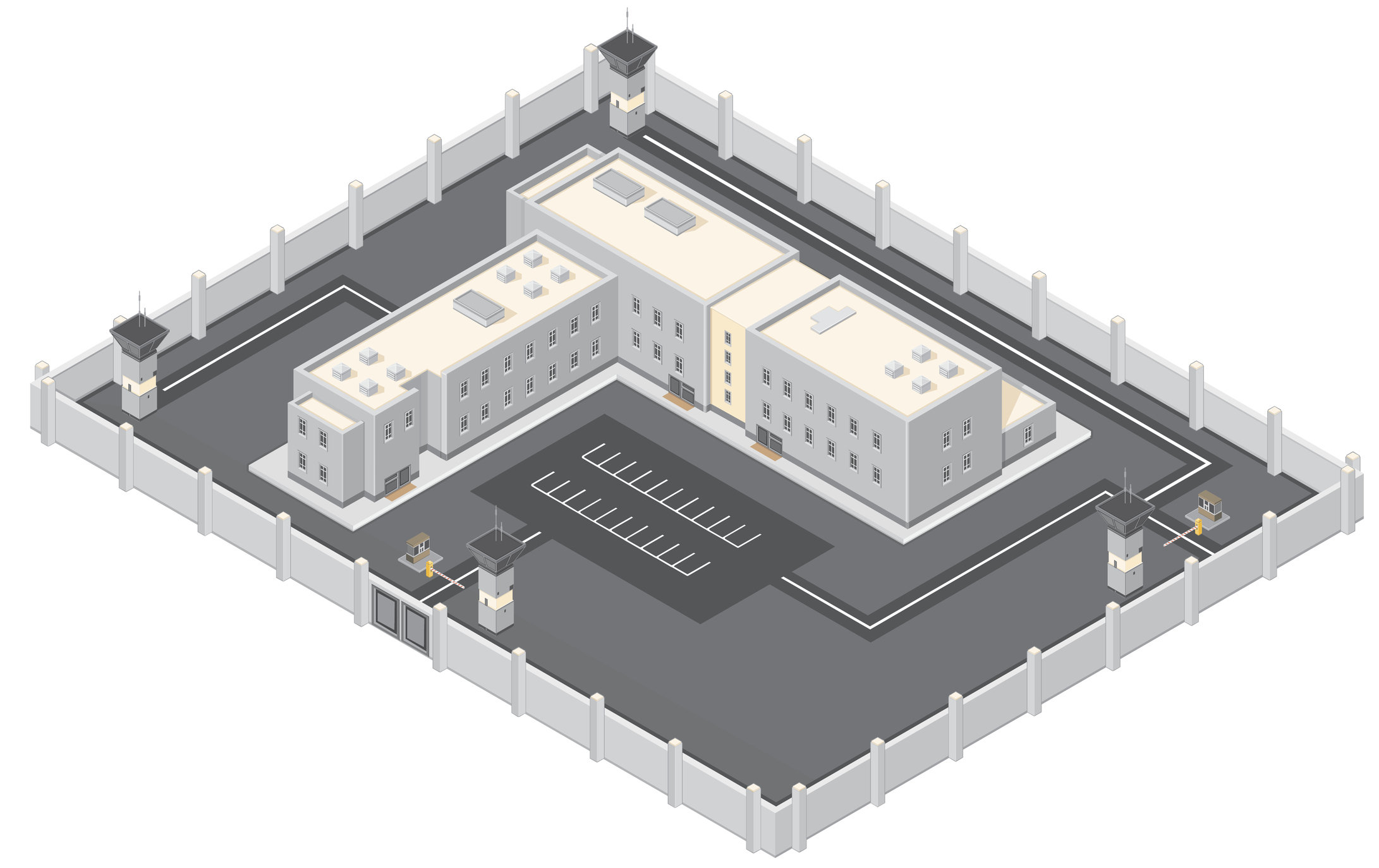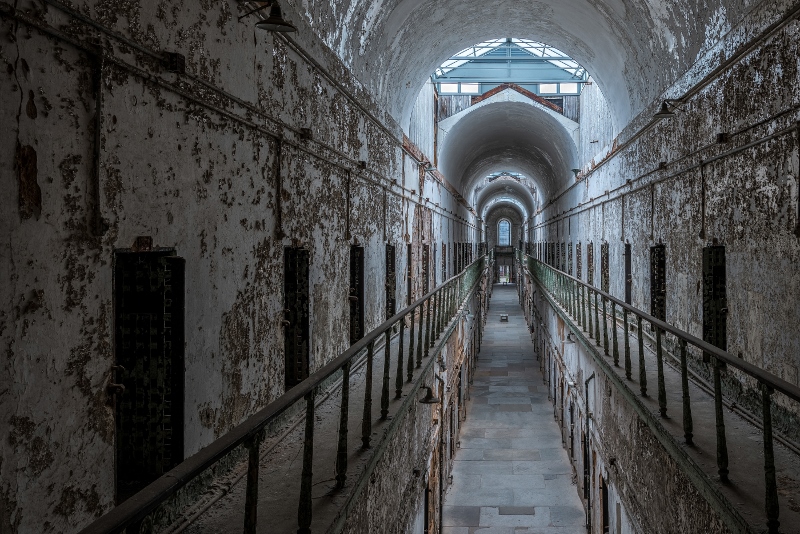 Editor’s Note: This article is the last in a series on the history of jails:
Editor’s Note: This article is the last in a series on the history of jails:
Part 1: Understanding Our Roots: A Brief History of Prisons
Part 2: Prison Reform: The Origin of Contemporary Jail Standards
Today, prison design mostly incorporates direct or indirect supervision: Rather than isolating inmates in cells in a linear fashion, the facility consists of “pods” clustered around a central monitoring station. Inmates spend most of their time in common areas, with corrections officers continuously monitoring their behavior and interacting with them directly.
In addition to enhancing inmate and staff safety, jails designed around pods are thought to be more cost-effective and foster a more positive, rehabilitative environment for inmates.
But this design is relatively new; it wasn’t until 1983 when direct supervision was formally recognized by the National Institute of Corrections. How did we get here?
19th Century
Modern prison design has its roots in the first “prison boom,” which started in the late 1700s. Under the influence of the Catholic Church, communities had increasingly begun to rely on imprisonment as punishment, rather than the previously used tactics of death, mutilation or exile. In England, prison construction was driven by the fact that authorities could no longer merely banish offenders to America; the Revolution had put a stop to that. In America, expanding civilization and the development of criminal law drove a similar construction boom.
The Gaols Act of 1823 introduced the concept of classification of inmates, and prison design during this time reflected the concept. Prison architects began to include varied geometric shapes in their designs, including rectangles, squares and circles.
The most famous prison design of this period is the Panopticon, envisioned by prison reform activist Jeremy Bentham. The Panopticon concept was a circular building with inmate cells built on the outside wall, with the keeper’s gallery rising in the center. This allowed the keepers to observe the prisoners, but not to be observed by them. Bentham even went so far as to suggest that inmates would not need to be under constant supervision because they would not know when they were being observed, so they would be compelled to behave at all times.
Elevation, section and plan of Jeremy Bentham’s Panopticon penitentiary, drawn by Willey Reveley, 1791
In the United States, only a few prisons were built in the Panopticon tradition. “Stateville,” built with inmate labor in Illinois between 1916 and 1924, is probably the most well-known. The central guard tower had underground access so additional officers could get to any cellblock in which there was a disturbance. Despite Bentham’s grand vision for a revolutionary prison design that would drastically reduce prison costs while enhancing inmate reform through menial labor, the Panopticon was not conducive to proper housing of prisoners. Ventilation was poor and the cells were damp, leading to disease and in turn, a high mortality rate. Overcrowding prevented the solitary confinement of unruly prisoners and eventually the prison was demolished.
The Panopticon design did, however, influence the next major design concept: radial design. This design retains Bentham’s central building housing the keeper, but features prison wings or hallways that radiate out like spokes on a wheel. Some cell designs included raised cells that allowed for better ventilation and heating and prevented prisoners from digging through the floor. Two limitations that continued to cause problems were the lack of proper sanitation and the inability of the keepers to inspect the prisoners easily.
20th Century
Prison designs continued to evolve around the turn of the century, and a lack of state or federal guidelines led to significant variations, although most prisons still sought to limit prisoner contact. By the 1930s and 40s, “telephone pole” design was the most popular. This design included a central corridor with housing wings built at 90 degrees from the corridor. Prisons built in this manner included the Maryland Reformatory, Soledad in California, Utah State Prison at Draper and Eastern State Penitentiary in Graterford, Penn.

A cell block in the Eastern State Penitentiary. Photo credit: Nagel Photography / Shutterstock.com
During the Great Depression and through World War II, prison building slowed tremendously but as soon as WWII ended, prison building in the U.S. took off. This new building boom was influenced by the medical model of criminal justice. The medical model held that offenders were not necessarily responsible for their actions; instead, society had to diagnose and cure the offender’s illness, which could be caused by issues that were psychological (mental illness), sociological (family environment), economic (unemployed) or physiological (improper diet). Prisons became responsible for rehabilitating offenders and successfully returning them to society.
By the mid-1970s, however, societal changes such as rising crime rates, conservative public attitudes and high recidivism rates forced a change toward a “get tough” attitude against offenders. In 1974, the “Martinson report” effectively ended the medical model. Martinson detailed the ineffectiveness of treatment programs and argued that rehabilitation was rarely successful.
Martinson’s ideas drove the rise of the justice model of criminal justice. Society began to believe that offenders had personal responsibility for their actions—they were not “sick.” Because offenders chose to commit crimes, it was thought they must be punished, not treated. Punishments were of determinant lengths of time, no longer dependent on the success of the treatment. This resulted in a new core function for corrections: to safely and securely control inmates—not to focus on their rehabilitation.
New Standards and the Direct Supervision Model
To understand the next major phase in prison design, we not only need to be familiar with the shift from the medical model to the justice model. We also need to acknowledge three main influences on corrections during the second half of the 20th century:
- Following WWII, the corrections industry experienced a shift toward a more bureaucratic model of administration. No longer was patronage and personal gain tolerated; instead competence, responsibility and accountability were emphasized. Selection and training of personnel was a priority as was refining the chain of command and specialization of medical, legal, accounting, fiscal planning and maintenance.
- In 1965, President Lyndon Johnson created the President’s Commission on Law Enforcement and Administration of Justice to address national crime and make recommendations for improving the functions of the police, courts and corrections. The report for corrections stated that the most important determinant for effectiveness was sufficient qualified staff. The report recommended dramatic improvements in the selection, training, supervision and accountability of correctional personnel. Recommendations for offenders included expanding community-based programs instead of incarceration, using community resources for reintegration, upgrading educational and vocational training, improving prison industries, expanding graduated release and furlough programs and providing separate treatment for special offender groups. The first correctional standards were created in part as a result of this report and became the basis for those used by the American Correctional Association’s Commission on Accreditation.
- Also during this time, prisoners began using the writ of habeas corpus and the Civil Rights Act to successfully bring litigation against correctional facilities to address violations of their federal civil rights. This resulted in more facilities operating under judicial orders and the entire industry facing liability for “failure to protect” inmates.
All these threads—managerial functions, the evolution of the bureaucratic model and judicial intervention—led to the creation of a new model called Direct Supervision. Using a combination of management and operational philosophy, design features and staff training, Direct Supervision places officers in constant and direct contact with the inmates, allowing them to get to know the inmates and recognize and respond to trouble before it escalates. Officers also become more responsible for the organization, supervision and control of the daily operation of a direct supervision housing unit, since they are directly within the housing unit. Direct Supervision has been credited with reducing vandalism, enhancing inmate and officer safety, and creating a more positive, less stressful environment for inmates and officers.
Direct Supervision was not only a new way of jail management; it also required new prison design. Local jails had traditionally been of linear design, rectangular buildings with corridors leading to single cells arranged at right angles to the corridor, resulting in intermittent surveillance (at best) of the cell. “Podular Remote” cellblock design sought to give officers better surveillance by incorporating a central control area. But this design created an “us against them” mentality because bars, walls and glass separated the officers from the inmates. Inmates became tense whenever officers entered “their” territory. Direct Supervision brings down the barriers, places control stations inside the inmate living areas and keeps inmates together in dayrooms rather than separately in cells. Inmates are aware they’re being constantly supervised, officers can step in quickly to address issues and electronic monitoring systems provide officers with additional protection.
The first jail facility incorporating Direct Supervision features opened in 1981 in Contra Costa, Calif. It was the result of a design competition held by the Federal Bureau of Prisons between three firms from New York, Chicago and San Diego. All three firms came up with similar designs to meet the BOP criteria for active and continuous inmate supervision. Today, this model is widely used across the United States.
REFERENCES
Woodruff, L. (2010) A Secondary Data Analysis of Staff Reaction to the Transition from a Linear Jail to a Direct Supervision Model in Kane County, Illinois.



